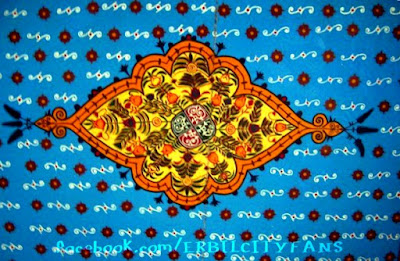 |
| Ceiling Art inside the citadel |
Located at the heart of the capital of Iraqi Kurdistan, the citadel is an archaeological treasure. One of the oldest continuously inhabited human settlement in the world. It boasts over 6,000 years of history and displays traces of numerous civilizations such as the Sumerian, Babylonian, Greek, Islamic and Ottoman.
To preserve and restore such a national treasure, the Kurdistan Regional Government created the High Commission for Erbil Citadel Revitalization (HCECR) in 2007. This measure should in the long run attract tourists from all over the world and contribute to the currently booming Kurdish economy.
Ahmed Jaf, the Public Relations Manager of the renovation commission believes that this restoration will make the citadel a major touristic center in the Middle East. According to him, the citadel is already an attraction in its own right.
“We have already started to attract large groups of tourists from all around the world. We have companies operating in Erbil, and in the US, with regular groups coming to Kurdistan.” he said.
The restoration process is divided into two separate sectors: one in collaboration with UNESCO, the other conducted individually by the Kurdish government-funded HCECR.
UNESCO’s work involves technical studies on how to renovate the buildings, with a particular focus on houses on the slope of the citadel. They are preparing a master plan for the citadel and consider its application as one of UNESCO’s World Heritage Sites.
On their part, the local team focuses mainly on maintaining the existing buildings, since most of them are in bad condition and face the risk of collapse.
Dara al-Yaqubi, the Head of HCECR, is proud to say that they have preserved 106 houses in the past eight months alone which despite the heavy rains that flooded parts of the city recently, stood firm. In the past, such rainstorms would usually destroy many of these old mud houses on the citadel.
But restoration is not the ultimate goal of the HCECR. Al-Yaqubi’s real hope is to 'bring life back to the citadel'. To that end, the HCECR is dedicated to renovating several houses along the citadel's main street where he hopes to set up traditional Kurdish textile workshops to act as live museums.
He also intends to place handicraft exhibitions and art galleries as well as sections for the staff to continue their research on the citadel.
The restoration commission has been approached by foreign partners who have shown interest in taking part in the renovation and later setting up their own research centers.
The French Institute for the Near East plans to restore two houses and use them for research and according to Jaf, similar interest has been expressed by delegations from Greece, Iran, Spain, Poland, Germany, Italy and the Czech Republic.
The combined effort of UNESCO, international actors and the HCECR (with full support from the KRG) makes al-Yaqubi optimistic enough to believe that they will be able to 'bring life back' in a reasonable time.
“Within ten years, we hope to have the citadel fitting our final vision.” said al-Yaqubi.
If al-Yaqubi’s predictions prove right, his team can then focus on other archaeological projects. The HCECR has already started to mark and isolate three main areas for possible archaeological excavations in the future.
“There are many things to research underground at Erbil Citadel,” said al-Yaqubi, “but what is above the ground is also valuable. This is what interests the people. We need to preserve this, and we cannot start digging yet.”
Al-Yaqubi does not want to rush. “The best way to save archaeology is to keep it underground, unless you know exactly how to excavate it. We will wait and plan for that.” he said.
* Jean Carrere is an intern reporter at Rudaw.
Source:http://www.rudaw.net
Follow Us:https://twitter.com/#!/ERBILCITYFANS




No comments:
Post a Comment